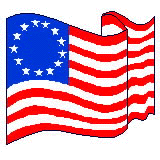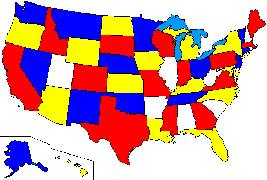 |
Then and Now
|
 |
 |
Then and Now
|
 |
| overview |
|
|
|
|
|
|
The Internet and Microsoft Power Point are used to integrate language arts and social studies at the upper elementary level. Students select one of the thirteen original colonies. They then use the Internet to research the colony and the modern day state the colony has become. The participants produce a multimedia project using Microsoft Power Point to present the information they obtained. Along the way they learn how to cite Internet sources, evaluate websites and download graphics from the Internet.
![]() Download
the FREE Adobe Reader to view all worksheet files (PDF Format) http://adobe.com/products/acrobat/readstep2.html
Download
the FREE Adobe Reader to view all worksheet files (PDF Format) http://adobe.com/products/acrobat/readstep2.html
Fifth Grade United States History and Geography:
5.4 Students understand the political, religious, social, and economic institutions that evolved in the colonial era, in terms of:
1. the influence of location and physical setting of the original 13 colonies
2. the major individuals and groups responsible for the founding of the various colonies and the reasons for their founding
3. the religious aspects of the earliest colonies
Writing
1.2 Establish a topic, important ideas, or events in sequences or chronological order
1.4 Create simple documents using electronic media and employing organizational features (e.g., passwords, entry and pull-down menus, word searches, the thesaurus, spell checks).
Instructional Objectives: Students will form pairs and select one of the thirteen colonies to research. They will then do an Internet site review comparing two different sites. Students will discover what factors determine the effectiveness and reliability of a website
Time required: 45 -60 minutes
Advance preparation: Copy worksheet #1
Materials: Worksheet #1 and a computer with Internet access.
Procedures: The teacher will help students select states and partners. Review worksheet and what information is required. Discuss with the students factors to consider in rating a site such as ease of navigation, reliability, bias, readability and content. The meaning of domain names such as com, edu, gov, net and org and the implied reliability of each should be discussed.
Activities: Students will
Student work sample: sample 1, sample 2
Evaluation: Review worksheets to determine if students completed correctly. Evaluate participation in classroom discussion.
Homework: Students will write a paragraph summarizing the results of the classroom discussion. Answer the question: What factors determine the effectiveness and reliability of a website?
Extension: Compare two search engines such as Google (www.google.com) and Ask Jeeves for Kids (www.ajkids.com).
Instructional Objectives: Students will learn how to save graphics and photos from the Internet to include in their Power Point slides. They will also learn how to cite an Internet source and the importance of doing so.
Time required: 45 -60 minutes
Advance preparation: Teacher should copy worksheet #2. Read how to cite sources at:
Materials: Worksheet #2 and computer with Internet access (floppy disk optional)
Procedures: Teacher reviews worksheet and demonstrates how to cite an Internet source and download from the Internet.
Activities: Students will
Student work sample:
Evaluation: Review worksheets, determine if students downloaded the graphics and saved correctly. Evaluate participation in classroom discussion on citing sources.
Homework: Students will go to the Tek Mom's site, review how to cite sources, and bookmark the page for further reference.
Extension: Have students use search engines to find other maps or graphics for their slides and cite their sources.
Instructional Objectives: Students will research first their colony, and then their present day state on the Internet. Two worksheets are provided to aid in taking notes.
Time required: Two or Three 45 -60 minute sessions
Advance preparation: Teacher should copy worksheets (Colony Report Notes and State Report Notes). Provide the following list of sites for students to use in their search.
Colonial Information Resources
State Information Resources
Materials: Worksheets and computer with Internet access
Procedures: Teacher will review worksheets (Colony Report Notes and State Report Notes) with students. Demonstrate how to navigate websites and use links for information. Review how to cite sources. Remind students to download any graphics for their slide show.
Activities: Students will
Student work sample: Colony Notes Samples (sample 1, sample 2) State Notes (sample 1, sample 2)
Evaluation: Review worksheets (Colony Report Notes and State Report Notes) and note cooperation in pairs
Homework: Each student will create an alphabetized bibliography from their notes
Extension: Students will design a table using Microsoft Word and enter the colonial data for all the colonies and states researched by the class.
Instructional Objectives: Students will create Power Point slides using information gathered about their colony and state. They will use good design principles as they develop slides according to teacher made criteria. Students will present their projects to the class.
Time required: Three or four 45 -60 minute sessions
Advance preparation: Teacher should copy worksheets (How to Build A PowerPoint Slide and Presentation Requirements) and become familiar with Microsoft Power Point.
Materials: Worksheet, state and colony notes and computer loaded with Power Point.
Procedures: Teacher will review presentation requirements with students. Teacher demonstrates how to use Power Point to create slides, select background, insert pictures, use word art, make text boxes and add animation.
Activities: Students will work in pairs to:
Student work sample: PowerPoint Presentations (sample 1, sample 2) Printer-friendly PDF (sample 1, sample 2)
Evaluation: Review presentations using a rubric. You can create a customized rubric at Rubistar.
Homework: Each student will create a grading rubric with which to judge the presentations. There is a great deal of information of rubrics on the web. Do a Google search with "multimedia rubric" for information.
Extension: Students review their classmates' presentations and rate them using the rubric they designed.
There are many sites that can be used to find information on states and the original thirteen colonies.
Here are just a few of them (also listed in lessons above):